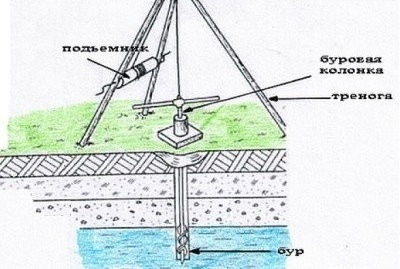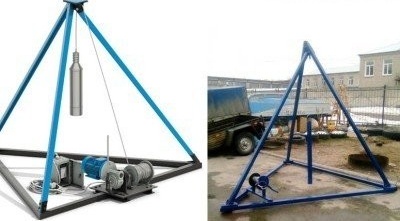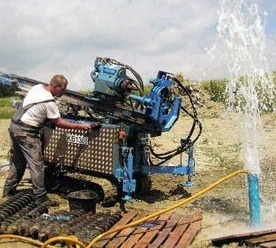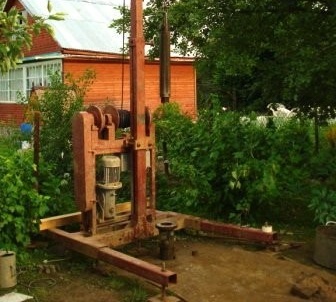How to make a drilling rig yourself: the simplest designs

A private source of drinking water on a private land plot is indispensable. Most often, the problem is solved by drilling a well, while the cost of the services of drillers will be the most expensive item of expenditure. Trying to reduce costs, many craftsmen tried to master the drilling technology on their own and many of them managed to provide the site with water. First you need a do-it-yourself drilling rig. Making it is not too easy, but possible.
Content
What rigs are there?
The design of the fixture depends on the method chosen for drilling the well. In shock-rope drilling, the soil is destroyed using a load that is simply thrown down. The loose soil is removed and then the cycle is repeated until the depth of the well reaches the required dimensions.
It is both easier and harder to remove the soil with a rotating drill. It is simpler because less physical effort is required, but more difficult, since such plants have a more complex structure, their size is larger, and the cost of creating them is higher. It is impossible to create some elements for a reliable drilling rig by yourself. Something will have to be bought at a specialized company, something can be ordered from an experienced turner. But the result is a completely professional unit that can be used on the side, starting a quite successful business as a hired driller.
Note! Homemade drilling rigs can be used not only for creating water wells, but also during installation of the pile foundation.
Specialists distinguish four types of small-sized drilling rigs (MGBU):
- Installation for UKB - shock-rope drilling. It is a frame with a triangular base. The working elements are a cable and a chisel or chisel attached to it.
- Screw drilling rigs, when using which the soil is removed with the help of a screw, while flushing the well with water is not used.
- Hydro-drilling rotary drilling rigs.
- Manual rotary installations - the simplest option, in which manual labor is used instead of an electric motor. Due to the high cost of physical labor, this type of MGBU is used quite rarely.
For the independent manufacture of even the simplest fixtures of this type, you will need a welding machine, drill and grinder, as well as working skills with all of these tools.

Manual auger drilling rig is the simplest device for drilling wells using manual labor. You can use an electric motor to take the drill to the surface
The simplest MGBU for shock-rope drilling
To create such a drilling rig you will need to do:
- collapsible bed;
- shock cartridge ("glass");
- bouncer.
To facilitate drilling, the installation is connected to a gear motor, on the drum of which a cable is wound with a fixed cartridge or choke. For effective operation, you need a cartridge weighing about 80 kg. With the help of a chute, the face is cleaned of destroyed soil. It is quite effective bailer on clay soils.
The main working element of this type of drilling rig is a cartridge or “glass”. For its manufacture, you will need a piece of thick-walled pipe with a diameter of about 80-120 mm, the heavier the material, the better. Triangular “teeth” are usually cut out below, which loosen the soil, but you can leave this part of the cartridge even. In addition, the lower edge of the “glass” is usually sharpened. Several holes are made from above to securely fasten the rope. The length of the cartridge can vary within 1-2 meters.

It is not difficult to make a drilling rig for shock-rope drilling, you will need a sufficiently heavy bobbin (drilling tool), a strong rope, a frame and a winch with a motor to facilitate work

In shock-rope drilling, a bailer is used to excavate the soil. In the photo, a home-made version of the tool for shock-rope drilling, which allows you to loosen and remove soil
Before starting work, it is recommended to use a drill to make a hole in the ground into which the cartridge will then lower. The diameter of this hole should be only slightly larger than the diameter of the cartridge.
The simplest screw design of the MGBU
The working element of such an installation is a drill. For its manufacture, you will need a steel pipe with a cross section of 100 mm. The upper end of the pipe is provided with an external screw thread. At the opposite end, a screw is made with a diameter of about 200 mm. One or two turns of the screw will be enough. Two steel knives should be welded to the ends of the screw so that they are in an upright position at an angle to the horizontal surface of the soil.
To rotate the drill was more convenient, you need to take another piece of pipe about 1.5 meters long and weld it to a tee with an internal screw thread. The tee is screwed onto a part of a collapsible rod. The length of a segment of such a rod is also 1.5 meters.

The scheme of the drilling rig: 1 - drill; 2 - a gate; 3 - tee; 4 - collapsible bar; 5 - coupling; b - tripod; 7 - hole; 8 - winch; 9 - a gear wheel
The drill is deepened into the soil, cranked three times, then removed to remove the loosened soil. The process is repeated until the recess reaches about one meter. Then the rod must be extended, for which, with the help of a coupling, another piece of steel pipe is attached to it.
To construct a well with a depth of more than eight meters, it will be necessary to fix the structure on a special tripod tower. In the upper part of this design, you need to make a hole in which the bar will move freely. Since the weight of the rod also becomes impressive as it increases, a winch should be used to lift the structure. The tower can be made of both metal and wood.
The operation of such a drilling rig is presented in the following video material:
How to make a reliable design?
To ensure that the drilling rig for wells is reliable and allows you to perform drilling operations at a professional level, it is necessary to purchase a number of elements manufactured in the factory using high-precision equipment. Need to purchase:
- swivel;
- drill rod;
- paddle drill;
- gear motor;
- motor pump with a sleeve;
- drilling fluid supply hose.
The frame for mounting this equipment can be made independently of durable steel.

The diagram clearly shows the device of a factory small-sized drilling rig with a swivel, a drill rod, a drill, an electric motor, a winch, a pump, etc.
A swivel is necessary for transmitting torque from the gear motor to the drill, as well as for supplying a flushing solution.In the swivel housing there is a movable part on which drill rods are fixed. Flushing fluid is supplied through a special sealed pipe. Although the design of this element does not differ in complexity, the life of the entire rig depends on the quality of its implementation. Due to the high loads, high-strength steel should be used to make the swivel, while observing the minimum clearance between the moving elements of the device. Poor swivel will fail after the production of several wells.
The drill rod is selected depending on the type of drilling (shock, rotational, flushing, etc.). The bar may have a round or hexagonal cross-section. It transfers the torque directly to the drill. In the process, the bar goes down and needs to be increased. For connection, special locks with a special conical or trapezoidal (rectangular) thread are used, which ensures the most reliable connection. According to the internal cross-section of the rod, a fluid is fed into the well, which softens the soil and allows drilling more quickly and successfully.
A drill is a working element designed to grind the soil. For professional use, special three-hazard drills are used, which are rotated in a cyclic manner. The diameter of the drill can vary between 80-350 mm. This element is made of high-quality steel, into which high-strength plates are fused, for example, VK-8. On hard soils, drilling in several passes is recommended. First, the so-called exploratory drilling is carried out with an 80 mm drill, then the borehole is drilled with a larger diameter until the hole reaches the required size.



5 comments